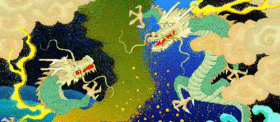Dragon Kung Fu
|
|
Dragon Kung Fu (龍形 Loong Ying) is one of the five animal styles of Shaolin Kung Fu. Its movements are based on the mythical Chinese Dragon.
| Contents |
History
The origin of dragon style kung fu is not known in its entirety so a close approximation, some of which is based on oral tradition, will have to suffice. It is said that the nun Wu Mui developed the basics of the art in AD 1570. Other schools believe the style to be much older than that. The style has evolved into a Northern and a Southern variant. In the 17th century, martial artist Gee Sim Sim See taught a martial art called Hakka Kuen in the Guangdong province of China which served as a precursor to the Dragon Style. In the mid 1800's, in a Buddhist temple of the Canton province, a monk named Tai Yut taught the style to Lam Yiu Quai. Lam Yiu Quai spread the southern style to many students through his schools in Guangzhou.
Techniques
Overview
The dragon stylist relies on a variety of fighting techniques that can be employed for a wide range of needs. The style uses techniques that can cripple or kill an opponent if the need arises or it can be used simply to control a minor street fighting situation.
Lam_Yil_Kwai.jpg
Lam_Yil_Kwai
Basics
The Dragon Kung Fu practitioner typically attacks with winding high yang attacks. One signature maneuver is the three finger claw techniques that utilizes the index, thumb and middle fingers, or all five fingers to do hard pinching attacks to the muscles, tendons and acupressure points; and rapid, close in palm attacks. Punching technics can be closed or open handed. Clawing and grappling techniques, in the imagined style of a dragon, are used. Kicks, no higher than waist level, are used to target sensitive areas such as the groin, knee, and foot. The waist, the largest and most central of all human muscles, receives great focus in Dragon Style. Efforts are made to strengthen, coordinate, and utilize this muscle to achieve powerful and quick movements. For example, when striking with the fist, more power can be exerted when the movement originates from the waist first, then flowing through the body, and finally into the fist.
Foot Work
In both the Northern and Southern Dragon Style systems, leg work is characterized by a zig-zag motion that mimics the imagined movement of the mythical Chinese dragon. In Southern style, smaller strides are emphasized to complement the system's short range combat style. In the Northern system, the strides are greater, utilizing the strength of the legs to move in and out of the opponent's range of attack with speed and force.
References
Chow, David; Spangler, Richard (1861). Kung Fu History Philosophy and Technique. Unique Publishing. ISBN 0-86568-011-6.
Steve Martin (2003) http://www.sojournpast.com/styles/dragon2.html Retrieved Oct. 07, 2004.
Shaolin Gung Fu Institute (2003) http://www.shaolin.com/page.asp?content_id=997 Retrieved Oct. 07, 2004.
Lisa Neuweld (1999) http://www.jadedragon.com/archives/martarts/dragonkf.html Retrieved Oct. 07, 2004.
Southern Shoalin http://www.loongying.co.uk/lineage.html Retrieved Oct. 07, 2004.

